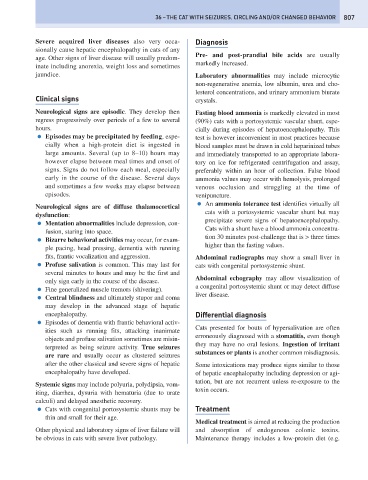Page 815 - Problem-Based Feline Medicine
P. 815
36 – THE CAT WITH SEIZURES, CIRCLING AND/OR CHANGED BEHAVIOR 807
Severe acquired liver diseases also very occa- Diagnosis
sionally cause hepatic encephalopathy in cats of any
Pre- and post-prandial bile acids are usually
age. Other signs of liver disease will usually predom-
markedly increased.
inate including anorexia, weight loss and sometimes
jaundice. Laboratory abnormalities may include microcytic
non-regenerative anemia, low albumin, urea and cho-
lesterol concentrations, and urinary ammonium biurate
Clinical signs crystals.
Neurological signs are episodic. They develop then Fasting blood ammonia is markedly elevated in most
regress progressively over periods of a few to several (90%) cats with a portosystemic vascular shunt, espe-
hours. cially during episodes of hepatoencephalopathy. This
● Episodes may be precipitated by feeding, espe- test is however inconvenient in most practices because
cially when a high-protein diet is ingested in blood samples must be drawn in cold heparinized tubes
large amounts. Several (up to 8–10) hours may and immediately transported to an appropriate labora-
however elapse between meal times and onset of tory on ice for refrigerated centrifugation and assay,
signs. Signs do not follow each meal, especially preferably within an hour of collection. False blood
early in the course of the disease. Several days ammonia values may occur with hemolysis, prolonged
and sometimes a few weeks may elapse between venous occlusion and struggling at the time of
episodes. venipuncture.
● An ammonia tolerance test identifies virtually all
Neurological signs are of diffuse thalamocortical
cats with a portosystemic vascular shunt but may
dysfunction:
precipitate severe signs of hepatoencephalopathy.
● Mentation abnormalities include depression, con-
Cats with a shunt have a blood ammonia concentra-
fusion, staring into space.
tion 30 minutes post-challenge that is > three times
● Bizarre behavioral activities may occur, for exam-
higher than the fasting values.
ple pacing, head pressing, dementia with running
fits, frantic vocalization and aggression. Abdominal radiographs may show a small liver in
● Profuse salivation is common. This may last for cats with congenital portosystemic shunt.
several minutes to hours and may be the first and
Abdominal echography may allow visualization of
only sign early in the course of the disease.
a congenital portosystemic shunt or may detect diffuse
● Fine generalized muscle tremors (shivering).
liver disease.
● Central blindness and ultimately stupor and coma
may develop in the advanced stage of hepatic
encephalopathy. Differential diagnosis
● Episodes of dementia with frantic behavioral activ-
Cats presented for bouts of hypersalivation are often
ities such as running fits, attacking inanimate
erroneously diagnosed with a stomatitis, even though
objects and profuse salivation sometimes are misin-
they may have no oral lesions. Ingestion of irritant
terpreted as being seizure activity. True seizures
substances or plants is another common misdiagnosis.
are rare and usually occur as clustered seizures
after the other classical and severe signs of hepatic Some intoxications may produce signs similar to those
encephalopathy have developed. of hepatic encephalopathy including depression or agi-
tation, but are not recurrent unless re-exposure to the
Systemic signs may include polyuria, polydipsia, vom-
toxin occurs.
iting, diarrhea, dysuria with hematuria (due to urate
calculi) and delayed anesthetic recovery.
● Cats with congenital portosystemic shunts may be Treatment
thin and small for their age.
Medical treatment is aimed at reducing the production
Other physical and laboratory signs of liver failure will and absorption of endogenous colonic toxins.
be obvious in cats with severe liver pathology. Maintenance therapy includes a low-protein diet (e.g.

